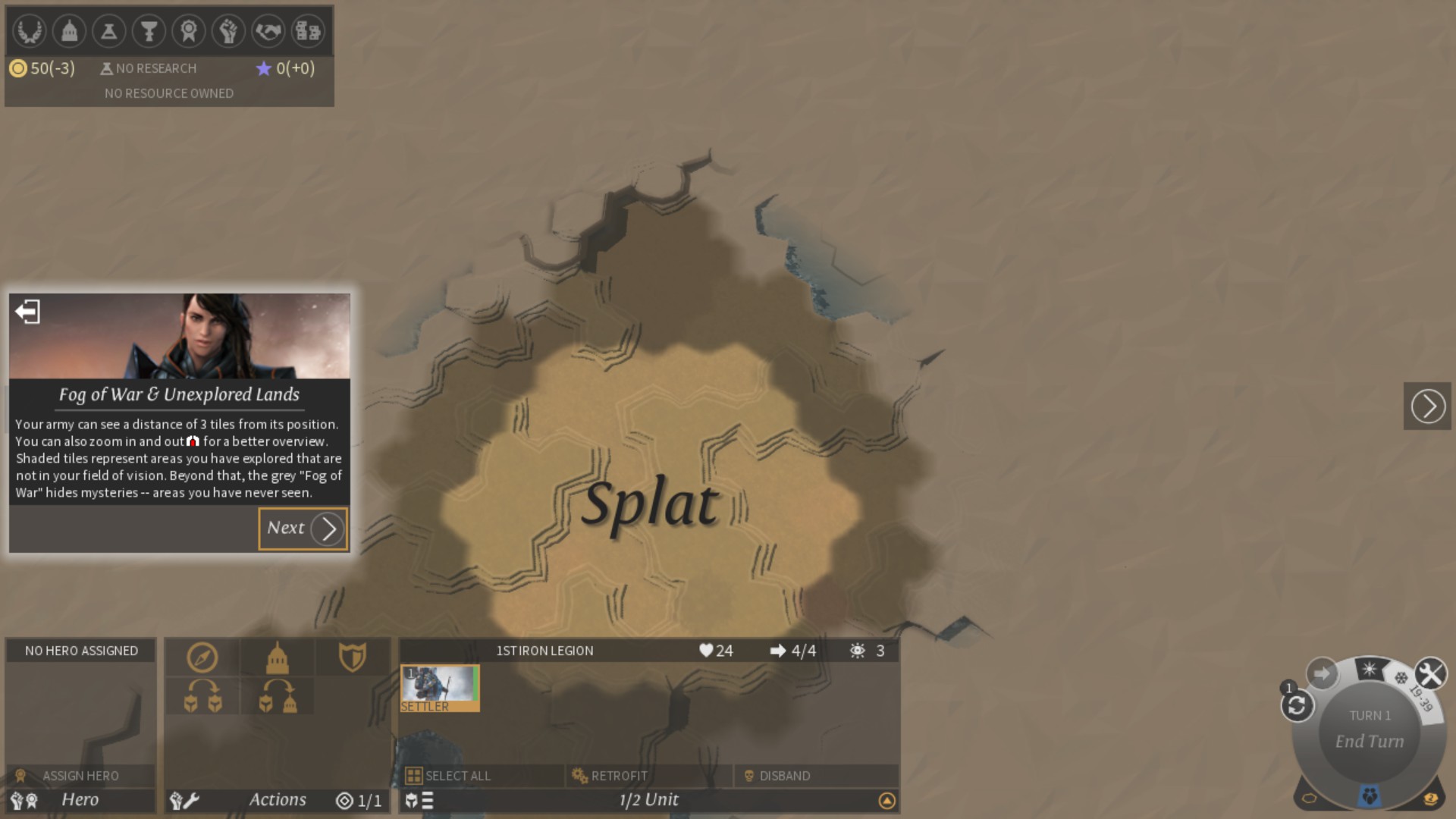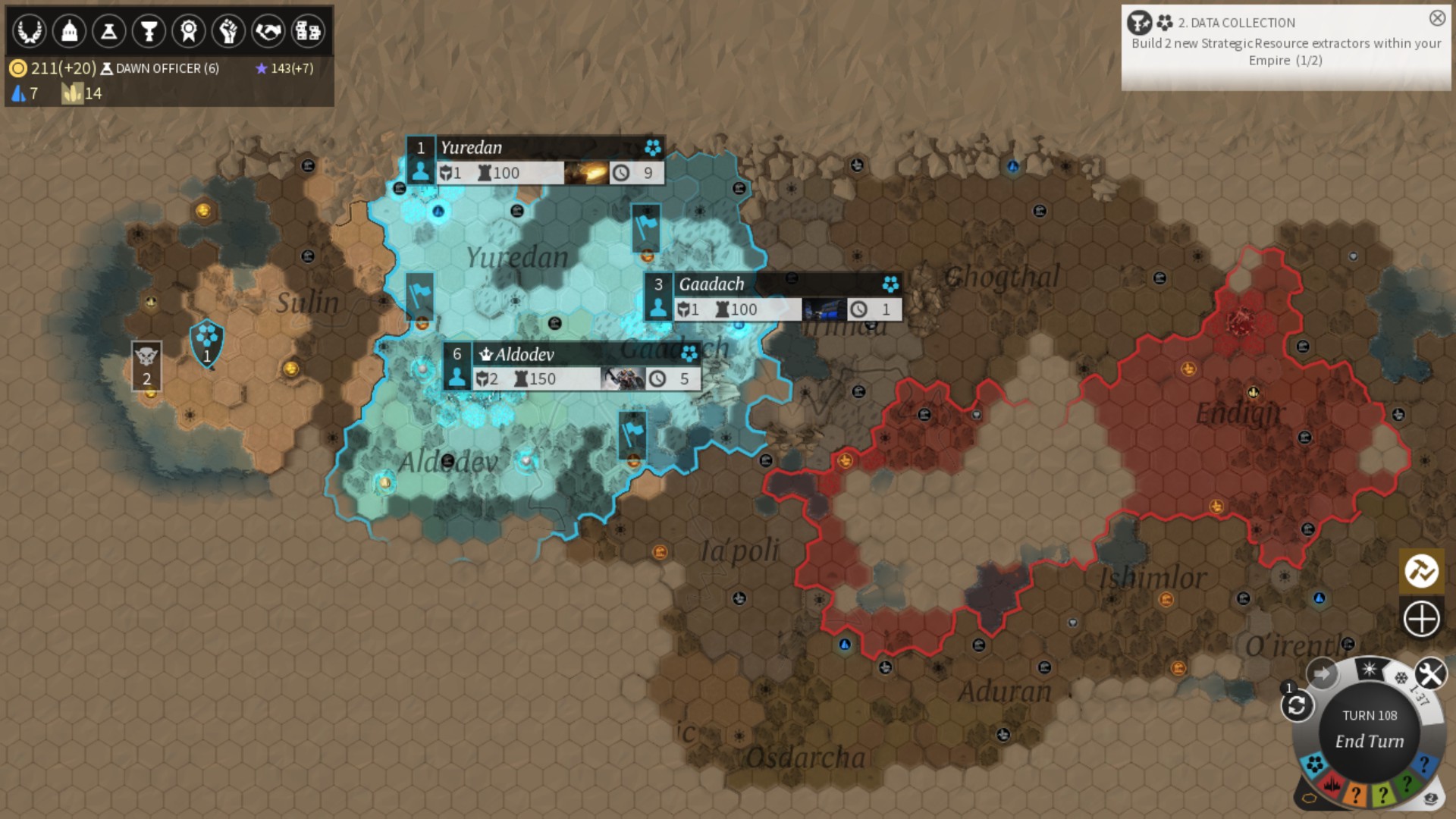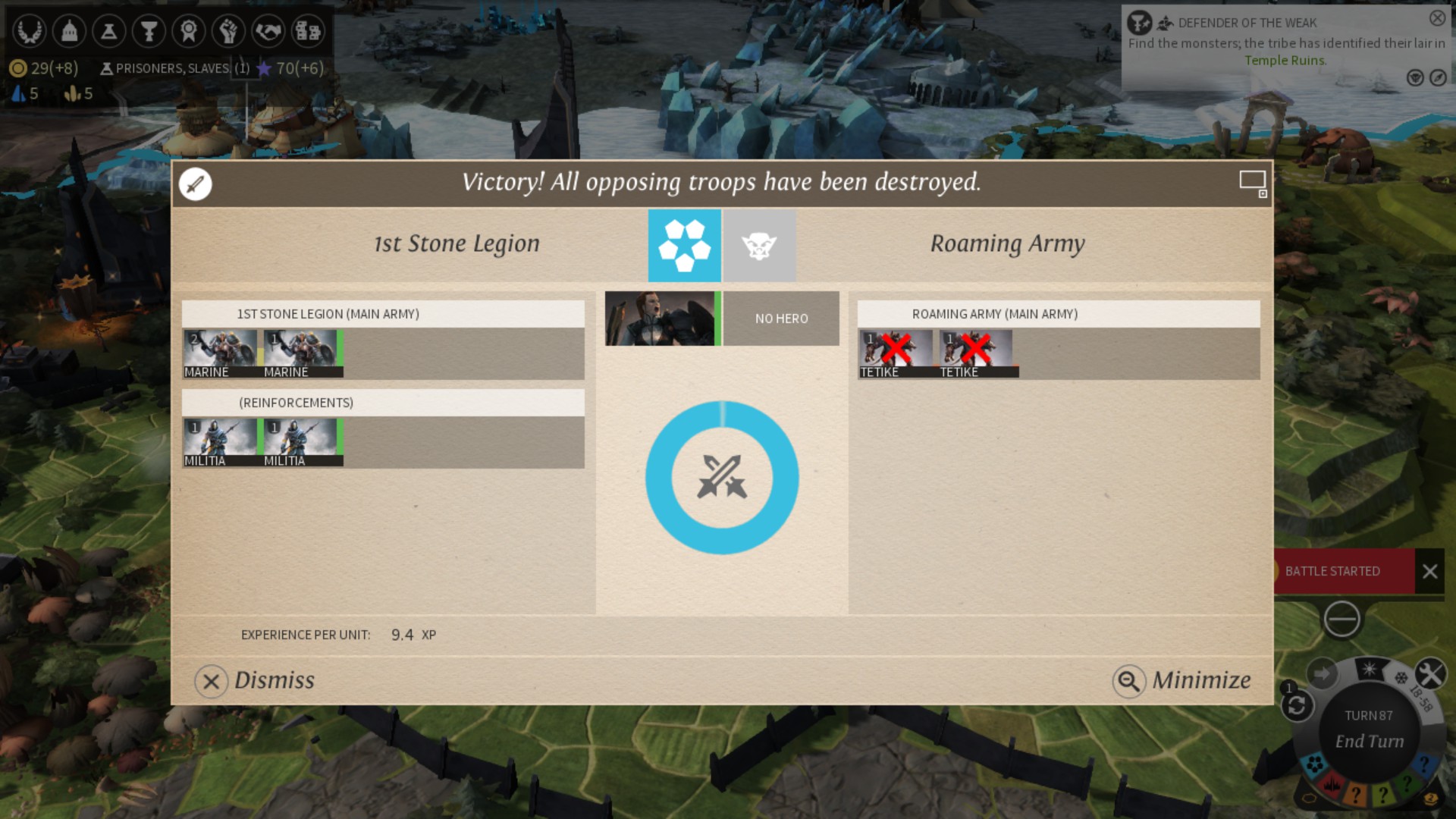There is no way to go about it with this review without admitting one thing — I have not beaten Endless Legend. To be honest, I’m not entirely sure this is the sort of game you can “beat”. Despite pouring hours into the game and learning several of its systems, I know that I am about as close to mastering it as the earth is close to the moon. It’s within reach, but it will take weeks beyond the game’s recent launch to truly get a handle on it. So what can I say then? Plenty, and it’s almost all good.
Endless Legend is the latest in a series of grand 4X strategy games by developer Amplitude. Whilst the previous Endless Space was obviously sci-fi, Legend leans heavily on the fantasy roots of Dungeons & Dragons. I don’t use that specific example casually either, as there are a wide variety of creatures and races inhabiting Endless Legend. Bipedal wolves, spider-human hybrids, giant glacial frost giants, and wandering undead spirits are just the tip of the iceberg for all the things you’ll encounter.

Not only are there a wide variety of creatures but also places and environments to navigate. My current game has me set far north amongst frozen wastes, but with a nearby desert and some forested coastal regions on either side. Among these regions are roving armies, quests to be found, and various untouched ruins that could hold either glory or dangerous foes. Endless Legend pushes it’s fantasy angle to the point of making the game truly feel almost more like a highly strategy focused RPG, whilst never surrendering it’s 4X focus.
The great thing about this is that you can approach the game at your own pace and focus. I went with the dwarf-like Vaulters and have been working towards a research victory. We’re already in tech level three, but not without facing a hard road getting there. Endless Legend is unforgiving yet fair, akin to Dark Souls in this respect. I lost my starting army early on in conflict with a nearby native tribe, and spent the good first hundred turns or so trying to get back from being the bottom nation on the board. We dealt with a two-faced neighboring nation trying to wipe out our meager remaining scout forces, had a food shortage during the winter, and fought to get a working industry up and running.
At first, I was outright frustrated at this. I felt completely out of my depth and like I was drowning. Then I realized just how wide an array of emotions I had felt so early into a game, a strategy game no less. I felt like I was House Stark of Winterfell, especially thanks to our threatening neighbors. I had to pacify them with pleasantries to keep them off my back (even though they eventually ended our peace treaty), all the meanwhile we slowly built up our cities. By the time my fourth region was set up, I finally could produce military units at the capital while the outlying cities built up our gold supplies to recruit new Hero units and to get more points for once every fifty or so turn Planning buffs.
There are so many intricate systems running at once that it’s hard to dissect them apart.

At first it’s all very Civilization-like, with a familiar hexagon map system. You have a settler and you place a city in one of many regions on the map. Instead of only controlling the adjacent hexagons, you now own the entire region. You can only directly collect from adjacent hexagons, but building city expansions lets you widen your grasp considerably. Benefits like roads for faster travel can also be researched. Instead of independent worker units, your workers are a resource you generate over time in each city independently. You can set each worker to a task in these city to increase percentage rates for output, all the while producing more workers through food supply.
Except you also have an industry output that will go to waste if you don’t have something in production; and unlike in Civilization, you can’t swap a task out with a new one, so set your building schedule wisely. Then there’s the science output that contributes to your research projects. You also have Dust, which is effectively gold, which can buy you many things but is not a crutch you can lean on. All of these plus the Influence resource for Planning and diplomacy have to be kept in check while you focus on what you need most. Every region has strengths and weaknesses in regular and Strategic Resources that can only be harvested with technology unlocks. You also get region buffs and additional construction projects beyond your city through research.
Then once you’ve got a basic footing on running the cities, combat comes running at you with a curve ball. Instead of just smacking stacks of units against one another like in the older Civilization games, or limiting units to a single square each like Civ V, Endless Legend puts a new spin on combat. All your armies within a region (even those garrison in cities) can join in on the battle, which takes place in a separate space utilizing the same map as the main game.
All the region’s geography transforms from a large swaft of land to a small battlefield, where you must direct your units in what to focus on. All you can tell them to do though is to either attempt to move one place or to focus on a particular enemy. Everything else is hands off, over the course of six rounds where the units fight in an order of initiative (yes, every unit has initiative values amongst all their other stats). If no side wins in six rounds, then it’s a draw.
Unfortunately this is the one case where the game reaches a bit of a vague point and needs a better clarification on how the combat system works. The game’s suggested movements and combat AI for your own faction always seem to make absolutely no sense, like moving your melee units behind ranged infantry, or sending one random ranged infantry group all the way across the map to an area with no clear advantage. It’s moments like these that leave something to be desired of Endless Legend, especially when almost everything else works so well and just intuitively clicks. It’s not even that the combat is bad per-say, more that it just is the least satisfying aspect the game has to offer.
Diplomacy, at least with the game’s AI, is likewise a bit on the limited side. While it does put an extra wrinkle into your Influence point spending, it’s fairly grindy to really build up positive relations with another nation. Unless your aim is to make alliances and/or to conquer the world, there’s not as much to it as you’d like. Still, with strangers and friends, it can get a great deal more interesting. The AI on its own however is mostly just pretending to have a personality, instead of being actively involved with the diplomatic scene such as in Alpha Centurai.

There’s also trading, which is a great alternative economic path to glory over becoming the most advanced technological race. You can either use your local resources to gain temporary buffs lasting around twenty turns, or sell them for more Dust. Establishing trade routes with neighboring nations is preferable, which does give diplomacy a great deal more value if that’s the path you take. You can also use trading to acquire mercenary units and new Heroes. That said, Heroes are not like in most strategy games, with unique powers. Instead, Heroes are more like specialized units that you can assign armor and weapon upgrades to. They’re more in line with a D&D character with their special abilities stripped away, along with several buffs. Another new wrinkle is how Heroes can be assigned as regional governors to provide economic buffs.
If you’d rather be the adventuring type though and recruit local minor factions to your side, you can have your armies take on quests from neighboring locals. There’s almost always a local group in every region, and over time you can recruit several to be assimilated into your nation. They not only provide their own stat boosts, but give you a unique unit to produce that would otherwise cost a ton of coin to acquire. Warmongers don’t have to do silly tasks for these peasants though, as you can also crush town after town in the region until they all serve you; although then you have to front the cost of rebuilding in order to get the buff, or you can just bribe them. Whenever one door closes in Endless Legend, at least two more open.
Speaking of varied options — the amount of control you have over the game world’s level generation is staggering. Imagine Don’t Starve’s resource controls combined with Age of Empires 2 and Civ 3‘s map generation templates. Plus game times ranging from a “Short” 150 turns to “Endless” 600 turns (the latter of which I prefer as the pacing of the game really lends itself to it). Whether you prefer offline or online, you have an immense amount of control over your scenarios, plus there’s mod support now with the most recent update.

Another well known feature of Amplitude’s Endless series is that the game design is not just by the developers themselves, but also strongly impacted by their community via the GAMES2GETHER initiative. Even now, post-Early Access in full retail release, the community gets to vote on new features and updates to the game. From minor tweaks to major design features, this is a game built with the community, not just for the community.
I can also not understate how pretty a game Endless Legend is. The world feels hand carved and brought vibrantly to life. Not only the style but the color choice in the art direction is superb. There’s influences from many games, comics, and old fantasy role playing games, and they all meld together beautifully here. It’s easy to just sit and look at the game for a minute, as the winds gentle bustle through the winter plains and the cities strike across the horizon like outreached hands. This is how you make a strategy game look great. The soundtrack likewise is fantastic, reminding one a bit of Jeremy Soule’s work on The Elder Scrolls series.
The Difficulty Difference: When you start up the game, there are a variety of difficulty settings, including the option to customize the difficulty. I advise toying around with the settings unless you want the default experience. Hardcore strategy fans should be right at home on Medium or higher difficulty.
What does your purchase net you?
Easily hundreds of hours worth of content even if you just go for the game’s standard edition. Mods, a very active fanbase, continued support from the developers at Amplitude all bode well for the game. I do not exaggerate when I say this is a game that cannot be “beaten”. The initial $35 asking price may seem steep, but it’s a steal, especially in comparison to the numerous expansions you would have to buy separately for the game’s biggest competitor, Civilization V. If you really want your money’s worth with all the bells and whistles, the Emperor Pack version is only ten dollars more and nets you the full OST and a few more pieces of in-game content.
Summary
Endless Legend is the kind of game that can be both an RPG, a management sim, an epic war sim, and Dwarf Fortress all in one. You live and die by your decisions, yet the game gives you so many options that it reaches Forza levels of accessibility. If there was ever a 4X strategy game for newbies alongside armchair warmongers and politicians, it’s this game. While the combat and diplomacy underwhelm, everything else from the art direction to maximizing each turn just shines so brightly you can hardly see the dull points.
Moment of Artistry
Weighing the profits of your nation to further your economy with the lives your people while winter bears down on your head an droaming armies harass your most recently built city that barely has a garrison; and then later turning around and outdoing neighboring nations through sheer force of will, planning, and cunning.
Pros
+ Amazing visuals evoke an epic feeling all their own
+ The game is d*** near truly Endless with how many gameplay options are included
+ Tries a mix of new and old ideas to great effect
+ Extremely flexible road to victory
+ Surprisingly good animation work for a strategy title
+ Unique blending of RPG elements works well here
+ Management Sim aspects are superb
+ Hero characters help shake up battles and country management
+ Surprisingly approachable, if you know what you’re getting into
Cons
– Combat needs more clarity
– Diplomacy with AI is limited
9.5/10
Endless Legend was developed & self-published by Amplitude. It is available on PC (Steam).
This review was conducted with a review copy of the Emperor Pack, sent to us by Amplitude. It includes one bonus minor faction (Ice Wargs), one bonus Hero (Namkang) and one bonus In-game unique faction trait. Other than that, gameplay wise, it is the exact same as a regular consumer copy of the game.

 …WOOLY DESERVES BETTER LOL!
…WOOLY DESERVES BETTER LOL!